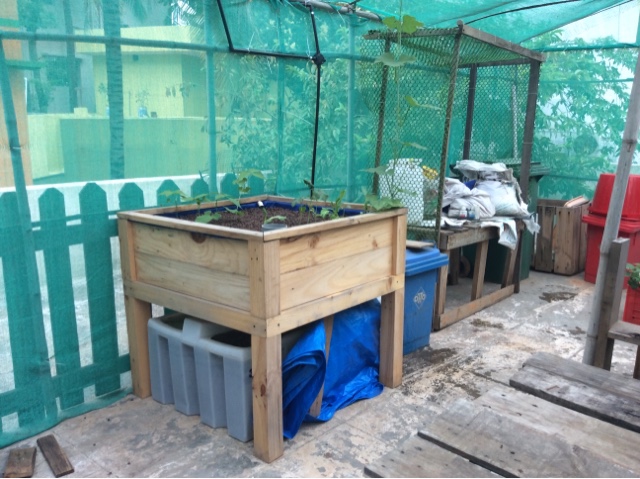A couple months ago, we noted that our soil had non-alarming levels of all the heavy metals tested for, except selenium. The selenium level was 40x higher than background for our area, and possibly in the range that we would want to do something about it. So we did some more digging (ha!) to verify if we did indeed have such high levels of selenium, find out if it is dangerous, and find out where it came from.
First, verification. We sent soil samples to a second lab (more local, and cheaper for single-element heavy metal testing). One sample taken with our fancy soil sampler tool, the other with a standard spade-dug hole from areas we knew we wanted to dig up. The results came back: < 1 ppm selenium in both samples!
What?
That was unexpected! But, it seems we have a bona fide controversy! Get some popcorn, ye lovers of analytical chemistry-themed drama!
We should preface this discussion by saying that, since it wasnt exactly the same sample analyzed by both labs, its possible that we hit a pocket of high-selenium soil in the first sample and missed it in the second sample. That is, both labs could technically be correct. But...we think the 30 ppm number is erroneously high, as well explain below.
On the analytical side of things, the two labs used slightly different techniques. Both labs digested the sample using nitric acid and hydrogen peroxide (to render it soluble and fully oxidize the selenium), and fed it into an inductively-coupled plasma (ICP). But the output of the plasma was analyzed by atomic emission spectroscopy (AES) at the first lab, and by mass spectrometry (MS) at the second lab. Both techniques suffer from plenty of spectral interferences (see here and
here
) in addition to the instrument-specific quirks that crop up with any piece of analytical equipment. There are ways of compensating for the spectral interferences, however, none of the known interferences are supposed to be able to increase instrument response from < 1 ppm to ~30 ppm.
Of the two labs, the second reported extensive quality control data, including blank runs (to make sure that no selenium is detected in a sample thats not supposed to have any), multilevel sample matrix spikes (where they add a known amount of selenium to our dirt and make sure the level increases by the amount they added), and standard control runs (where they run other materials with known selenium content to make sure selenium is detected at the expected level). The first lab did not, but responded by email to say that they run two standard control samples per batch...one of which came back almost three times as high as it should have, and said that other samples in the same batch also showed elevated selenium levels. But if it were random jumps in apparent selenium, its weird that both of our samples were so close to each other. Did the other samples show up to 30 ppm selenium? We dont know. We asked enough questions that the first lab finally said to just send them another sample and theyd run it for free (not including shipping, of course). We havent taken them up on the offer yet. In any case, we were leaning toward higher confidence in the second labs (low selenium) results anyway.
Nevertheless, if the first lab was wrong, we wanted to know why. So, we took to the interwebs to search for possible interferences from other components in our dirt that might not have been accounted for . The first lab mentioned that they used the 203.985 nm emission line to measure the selenium, and we found an awesome tool from NIST that conveniently allows one to see what other elements might emit in the same range. The general fertility test for our soil said we had really high levels of Mg, Ca, and P, so we started there. But Ca has nothing in the right wavelength range, and Mg and P arent supposed to affect that the selenium measurement at that wavelength very much. According to the first lab, molybdenum is the only known interference at that wavelength, but we couldnt find anywhere that confirmed that, or to what degree it interferes.
 |
| What the ICP-AES spectrum of our soil might look like in a perfect world, with equal concentrations of Mo, Se, and Ca, an instrument resolution of 0.035 nm, and no bcvkground noise. If anyone wants to buy us an actual ICP, well gladly replace this figure with a real graph! |
Unfortunately, there arent a lot of qualitative biological indicators that could help us differentiate 30 ppm selenium from 1 ppm selenium, either. Sometimes selenium hyperaccumulators, such as some species of
Astragalus and
Stanleya, can be used to gauge if a soil is high in selenium, but our yard didnt have any of the hyperaccumulator species growing when we moved in, and selenium toxicity in most plants doesnt usually present itself until much higher selenium levels than 30 ppm. (Unfortunately, the numbers cited for selenium toxicity in wheat and peas in that article dont actually appear in the paper it cited!) Similarly, we couldnt find any data suggesting that wed be able to notice defects in our soil invertebrates or other wildlife at 30 ppm.
Second, would it be dangerous anyway, even if we were at 30 ppm? The first lab said possibly, quoting an EPA document that says 20 ppm is the threshold level at which they start to dig deeper into things like bioavailability (which depends on soil pH, soil sulfate content, the form of selenium in the original source, and other factors). On the other hand, A&L Eastern Labs says not to worry about concentrations less than 50 ppm. What about a local office? We emailed the Colorado extension service, who said that the main risks in this area are forage plants that hyperaccumulate selenium, leading to toxicity in grazing livestock, but not normally vegetables grown for human consumption. If it were accumulated to dangerous levels in our veggies, we would expect to see symptoms like brittle fingernails and hair, and we havent yet.
Third, where could it have come from? Most soil selenium comes from weathering seleniferous rocks, volcanic eruptions, coal burning, and metal refining. We wondered if it might have been from spilled chicken feed, since we were dragging our chicken tractor around the yard with our extremely messy broilers last summer, and the chicken feed they spilled was fortified with selenium. However, it turns out the FDA only allows 0.3 ppm selenium in poultry feed, which means that, unless our feed is mixed by scofflaws, wed have to have our soil essentially made out of composted chicken feed with very little selenium transport for that to be the main contributor. The broilers were messy, but not messy enough to build up 8" of soil throughout the yard from spilled feed!
Final conclusions? The 30 ppm was a false positive. Also, that was a lot of research hours spent to decide theres nothing to worry about.
Time to get back to the garden!
 |
| The garden in August: some late tomato blight, some powdery mildew, lots of raccoon, squirrel, and chicken damage, but no dangerous levels of selenium! |





















































